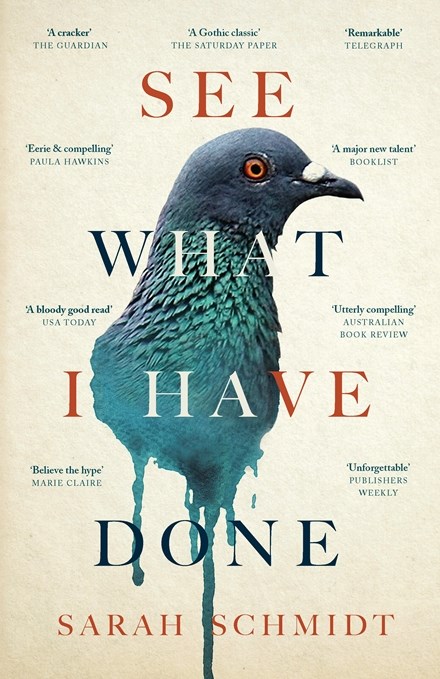by Sarah Schmidt
Publisher: Hachette Australia
Copyright Year: 2017
Synopsis
Lizzie Borden took an axe. Or did she? On 4 August 1892 Andrew and Abby Borden were murdered in their home in Fall River, Massachusetts. During the inquest into the deaths, Lizzie Borden was arrested and charged with the murder of her father and her stepmother.
Through the eyes of Lizzie’s sister Emma, the housemaid Bridget, the enigmatic stranger Benjamin and the beguiling Lizzie herself, we return to what happened that day in Fall River.
Reviewer: Moraig Kisler
‘Lizzie Borden took an axe
And gave her mother forty whacks
When she saw what she had done
She gave her father forty-one.
The rhyme is familiar, but I was unaware until reading Sarah Schmidt’s debut novel See What I Have Done, that Lizzie Borden was acquitted. Schmidt’s historical and gothic representation of Lizzie’s story opens on a sweltering day. ‘Summer heat ran up my neck like a knife.’ From the opening paragraph, there’s an uncomfortable feeling something is not right with Lizzy. In the blood-soaked lounge room, she examines her father’s mutilated corpse like a scientific specimen. She notices the gold ring on his pinkie finger. ‘I gave him that ring for his birthday when I no longer wanted it.’ Her responses are increasingly inappropriate. As the novel progresses, we’re given a chilling glimpse into Lizzie’s mind and begin to doubt her sanity.
The events surrounding the murders of Andrew Borden and his wife (Lizzie’s step-mother who Lizzie refers to as Mrs Borden) are examined through the eyes of four people: Lizzie, her sister Emma, the maid Bridget and Benjamin a man of violence and perhaps a hired killer.
Lizzie’s sister Emma no longer lives at home when the murders are committed. Although she comes to Lizzie’s aid, there is a deep-seated resentment between the sisters. Emma is unsure of Lizzie’s hand in the death of her father and step-mother. Emma’s growing suspicions of her sister’s guilt is an uncomfortable read.
Schmidt’s writing is accomplished for a debut novelist. Her descriptions are evocative, sometimes graphic and at times truly horrifying. Throughout the novel, there are hints of decay and putrefaction, an apt metaphor for the disintegrating Borden family. Schmidt captures the tension in the home and the unnerving conversations over meals. It is hinted that the family has been poisoned; by Lizzie or perhaps by the mutton stew that sits on the stove and is continually warmed up, it is not clear. What I loved about Schmidt’s writing is the underlying hints of who did what. The imagination is left to run wild.
Is Andrew Borden’s destruction of Lizzie’s newly constructed pigeon loft a credible motive for murder? Or could the murderer be the mysterious and violent man hiding in the loft?
Schmidt throws in a few red herrings to keep the reader guessing, but it is Lizzie’s voice, hinting of dark madness, that turns the blood cold.
I loved this book, a gripping portrayal of family resentments and terrible consequences. My advice, don’t miss out a good read which caters to fans of the gothic and historical as much as to lovers of murder.
